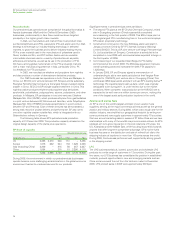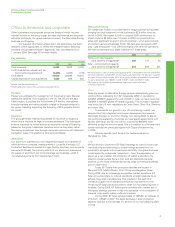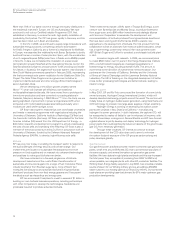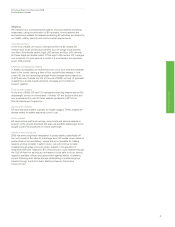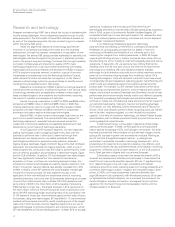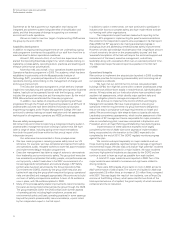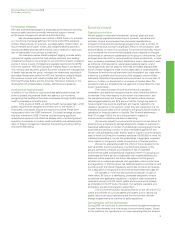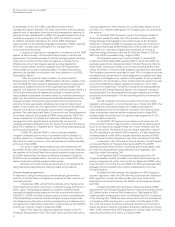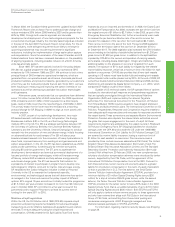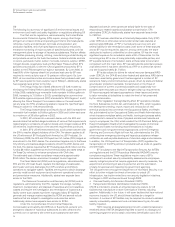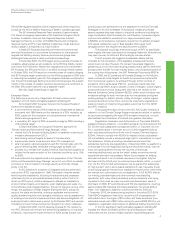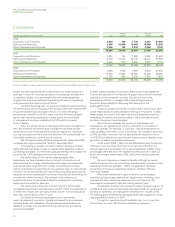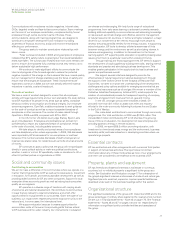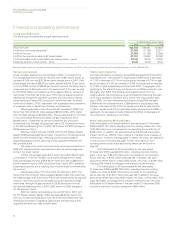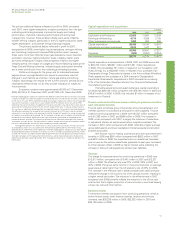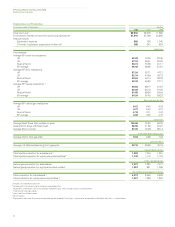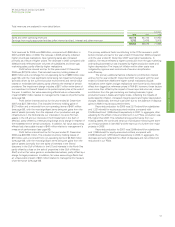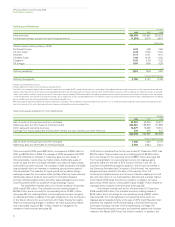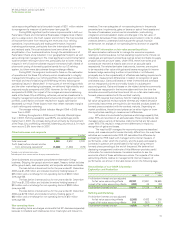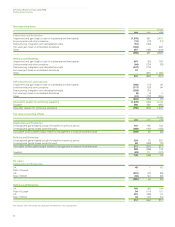BP 2008 Annual Report Download - page 47
Download and view the complete annual report
Please find page 47 of the 2008 BP annual report below. You can navigate through the pages in the report by either clicking on the pages listed below, or by using the keyword search tool below to find specific information within the annual report.
BP Annual Report and Accounts 2008
Performance review
US
The following is a summary of significant US environmental issues and
environment and health and safety legislation or regulations affecting BP.
The CAA and its regulations, administered by the United States
Environmental Protection Agency (EPA) require, among other things:
stringent air emission limits and operating permits for chemicals plants,
refineries, marine and distribution terminals and exploration and
production facilities, strict fuel specifications and sulphur reductions;
enhanced monitoring of major sources of specified pollutants; and risk
management plans for storage of hazardous substances. This law affects
BP facilities producing, storing, refining, manufacturing and distributing oil
and products as well as the fuels themselves. Federal and state controls
on ozone, particulate matter, carbon monoxide, benzene, sulphur, MTBE,
nitrogen dioxide, oxygenates, lead and Reid Vapor Pressure affect BP’s
activities and products. Under the CAA all gasoline produced by BP is
subject to the EPA’s stringent low-sulphur standards. By June 2006, at
least 80% of the highway diesel fuel produced each year by BP was
required to meet a sulphur cap of 15 parts per million (ppm). By June
2007, all non-road locomotive and marine diesel fuel produced each year
by BP was required to meet a sulphur cap of 500ppm. Additionally, states
have separate laws similar to the CAA.
The Energy Policy Act of 2005 affects the US fuels market by:
eliminating the Federal Reformulated Gasoline (RFG) oxygen requirement
in May 2006; establishing a renewable fuels mandate (4 billion gallons in
2006, increasing to 7.5 billion in 2012); consolidating the summertime
RFG volatile organic compound (VOC) standards for EPA Regions 1 and 2;
allowing the Ozone Transport Commission states on the east coast to
opt any area into RFG; and allowing states to repeal the 1psi Reid Vapor
Pressure waiver for 10% ethanol blends.
The Energy Independence and Security Act of 2007 increased the
renewable fuel mandate to 9 billion gallons in 2008 and further each year
to a maximum of 36 billion gallons in 2022.
In 2001, BP entered into a consent decree with the EPA and
several states that settled alleged violations of various CAA requirements
related largely to emissions of sulphur dioxide and nitrogen oxides at BP’s
US refineries. Implementation of the decree’s requirements continues.
In 2001, BP’s US refineries entered into a civil consent decree with
the EPA to resolve alleged violations of the CAA. The decree applies to all
the US refineries of BP Products North America Inc. (BP Products). On
19 February 2009, the EPA and US Department of Justice (DOJ) lodged an
amendment to the 2001 decree. The amendment applies only to the Texas
City refinery and resolves alleged violations of both the 2001 decree and
the CAA. The decree requires that BP Products pays a $12 million civil fine,
funds a $6 million supplemental environmental project and takes steps at
the Texas City refinery to enhance compliance with CAA rules.
The estimated cost of these compliance measures is approximately
$150 million. The decree amendment is subject to court approval.
The Clean Water Act (CWA) and its regulations, administered by
EPA and the US Coast Guard, regulate the discharge of wastewater,
stormwater and toxic discharges from BP’s onshore and offshore
operations to navigable waters. Facilities are required to obtain discharge
permits, install control equipment and implement operational controls
and preventative measures. Additionally, states have separate laws
similar to the CWA.
The Resource Conservation and Recovery Act (RCRA) and its
regulations, administered by the EPA, regulate the storage, handling,
treatment, transportation and disposal of hazardous and non-hazardous
wastes and require the investigation and remediation of locations at a
facility where such wastes have been managed. Many BP facilities
generate and manage wastes regulated by RCRA and several include
locations that are subject to investigation and corrective action.
Additionally, states have separate laws similar to RCRA.
Under the Comprehensive Environmental Response,
Compensation and Liability Act (CERCLA or Superfund), persons who
arranged to dispose of hazardous substances at a site, persons who
currently own or operate a site where such substances have been
disposed and certain other parties are strictly liable for the cost of
responding to related hazardous substance contamination. EPA
administers CERCLA. Additionally, states have separate laws similar
to CERCLA.
BP has been identified as a Potentially Responsible Party (PRP)
under CERCLA or otherwise named under similar state statutes at
approximately 809 sites. A PRP or named party can incur joint and
several liability for site remediation costs under some of these statutes
and so BP may be required to assume, among other costs, the share
attributed to insolvent, unidentified or other parties. BP has the most
significant exposure for remediation costs at 50 of these sites. For the
remaining sites, BP is one of many potentially responsible parties, and
BP expects its share of remediation costs at these sites to be small in
comparison with the major sites. BP has estimated its potential exposure
at all sites where it has been identified as a PRP or is otherwise named
at a site is approximately $1.7 billion.
BP is also subject to claims for natural resource damages (NRD)
under CERCLA, the OPA 90 and other federal and state laws. NRD claims
have been asserted by government trustees against a number of BP
operations. Many environmental clean-ups are driven by state and federal
groundwater protection standards. Contamination or the threat of
contamination of current or potential potable (and occasionally non-
potable) water resources can result in stringent clean-up requirements.
BP has encouraged risk-based approaches to these issues and seeks
to tailor remedies at its facilities to match the level of risk presented
by the contamination.
Other legislation that significantly affect BP operations includes:
the Toxic Substances Control Act, administered by EPA, which regulates
the development, testing, import, export and introduction of new
chemical products into commerce; the Occupational Safety and Health
Act, administered by the Occupational Safety and Health Administration,
which imposes workplace safety and health, training and process safety
requirements to reduce the risks of physical and chemical hazards and
injury to employees; the CAA, which created the US Chemical Safety and
Hazard Investigation Board which investigates the causes of chemical
accidents and makes non-binding recommendations to industry,
government and non-governmental organizations; and the Emergency
Planning and Community Right-to-Know Act, administered by the EPA,
which requires emergency planning and hazardous substance release
notification as well as public disclosure of chemical usage and emissions.
In addition, the US Department of Transportation (DOT) regulates the
transportation of the BP’s petroleum products such as crude oil, gasoline
and chemicals.
BP is subject to the Marine Transportation Security Act (MTSA)
and regulations and the DOT Hazardous Materials (HAZMAT) security
compliance regulations. These regulations require many of BP’s
businesses to conduct security vulnerability assessments and prepare
security mitigation plans that require upgrades to security measures, the
appointment and training of security personnel and the submission
of plans for approval and inspection by government agencies.
The US government through the Department of Homeland Security, in an
effort to further mitigate the threat of terrorism to critical US
infrastructure, has implemented two new security legislation initiatives,
that began in 2007 and has continued through 2008:
• Chemical Facility Anti-Terrorism Standard (CFATS).
• Transportation Workers Identification Credential (TWIC).
CFATS is intended to provide an enhanced security posture for US
facilities that manufacture or store Chemicals of Interest, including
gasoline. Additionally, in the future, it will cover facilities that have national
economic impact to the US, should these facilities be a target for
terrorism. A number of BP facilities may be required to conduct a detailed
security vulnerability assessment and a detailed security plan for each
facility impacted.
TWIC requires all designated personnel with unescorted access to
restricted areas of MTSA designated facilities to submit to a background
screening programme and to obtain a biometric identification card. All of
46


